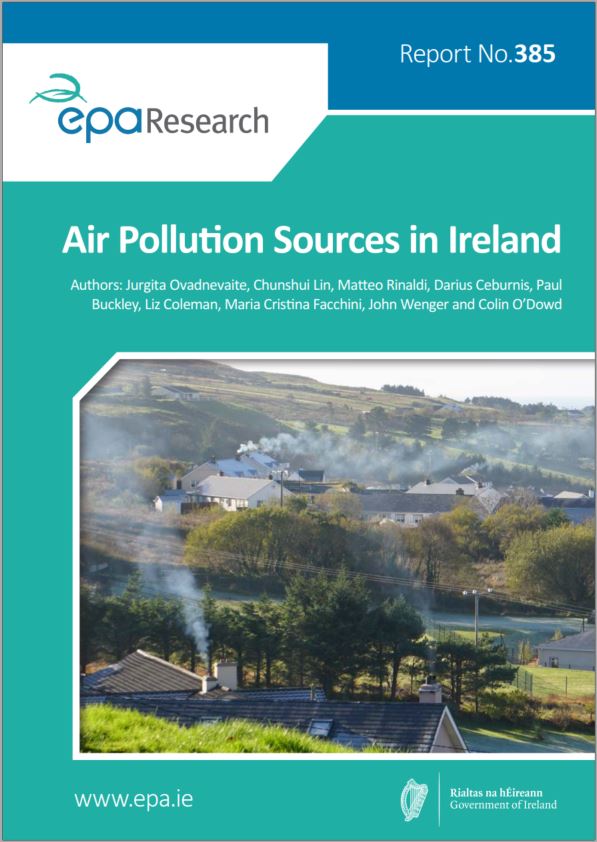Research 385: Air Pollution Sources in Ireland
Authors: Jurgita Ovadnevaite, Chunshui Lin, Matteo Rinaldi, Darius Ceburnis, Paul Buckley, LizColeman, Maria Cristina Facchini, John Wenger and Colin O’Dowd
Summary: The project successfully established the AEROSOURCE network, comprising three sophisticated aerosol mass spectrometer nodes positioned in strategic locations: Carnsore Point (regional background), Dublin (urban environment) and Mace Head (marine background). It enhanced the National Transboundary Air Pollution Network with near real-time aerosol chemical speciation (including organic matter) and source apportionment capabilities.

Identifying Pressures
Air pollution is a major cause of health issues in Ireland and addressing it requires a better understanding of particulate matter (PM) sources. Despite generally good air quality, on account of prevailing oceanic air masses, AEROSOURCE revealed that extreme air pollution events, spanning conurbations across the entire country, occur frequently in wintertime. During these events, the PM limits recommended by World Health Organization are regularly breached (up to 1 in 5 days) during winter.
AEROSOURCE demonstrated that even though strict emission standards have resulted in downward trends of sulphate, these did not necessarily translate into an equivalent reduction of overall PM levels. A deficiency of information on major PM sources, especially those of carbonaceous components (organic matter and black carbon), resulted in insufficient knowledge relating to the cause of the pollution events and, in turn, prevented the development of informed air policy. Moreover, in some cases, policies promoting one environmental action but which was detrimental to another were found to exist; an example is the promotion of biomass as residential heating fuel as being “carbon neutral” and this reduces greenhouse gas emissions at the expense of clean air.
Informing Policy
The new National Ambient Air Quality Monitoring Programme marks an important advancement; however, it is not designed to provide chemical speciation or inform on sources without which adequate clean air policies cannot be developed.
The AEROSOURCE network revealed that carbonaceous aerosol prevails over historically dominant inorganic species, such as sulphate and nitrate, with the carbonaceous species contributing from 60% to 90% of PM1 mass (the mass of all particles ≤ 1 μm in aerodynamic diameter). Nevertheless, they are not routinely classified in regulatory air quality networks.
This study also highlighted the disproportionate effects of some sources. Peat and wood burning, in particular, are minor contributors to energy budgets, yet they are the major cause of extreme pollution events. Moreover, they were shown to be important in toxicity terms, as they possess a high oxidative potential and likely contribute substantially to the health effects alongside other expected culprits, such as coal and liquid fuel combustion.
AEROSOURCE demonstrated how critical it is to augment standard regulatory air quality networks with an aerosol mass spectrometry approach that can identify the main pollution contributors, which, in turn, can better inform policy measures and enable specifically targeted and sophisticated emission reduction strategies while minimising the risk of unintended consequences in other policy areas.
Developing Solutions
We have demonstrated that the AEROSOURCE “proof-of-concept” network can meet the challenges listed previously by enabling a better-informed and more sophisticated policy development. We thus recommend transforming the proof-of-concept network into a permanent national aerosol mass spectrometry network alongside the National Ambient Air Quality Monitoring Programme to provide a quantitative source apportionment and a continuous measurable assessment of policy implementation outcomes. Changes in emissions and their contributions and gathering up-to-date information on air pollution offenders in constantly changing environment are only possible with a permanent network rather than ad hoc facilities.
The AEROSOURCE approach underpins both the planned National Clean Air Strategy and the National Climate Mitigation Plan, as it identifies the real culprits of air pollution and climate forcers and, more importantly, allows synergetic, or co-beneficial solutions for air quality and climate change mitigation to be found.
https://www.epa.ie/media/epa-2020/research/epa-funded-research/Report-cover-385.jpg